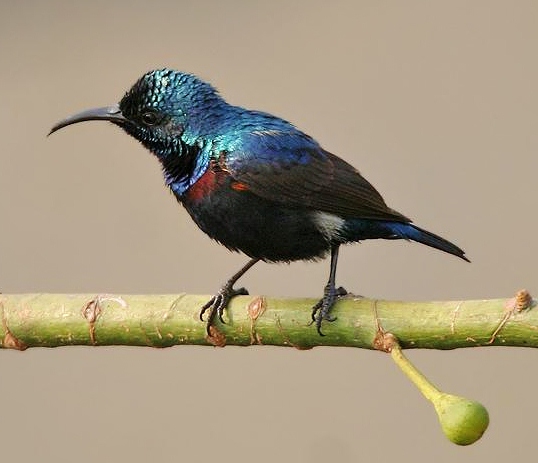Cinnyris asiaticus
 |
| Photo by Raghuvanshi Rajesh (Internet Bird Collection) |
Common name:
purple sunbird (en); beija-flor-púrpura (pt); souïmanga asiatique (fr); suimanga asiático (es); purpurnektarvogel (de)
Taxonomy:
Order Passeriformes
Family Nectarinidae
Range:
This Asian species is found from the western Arabian Peninsula, through Iran, Afghanistan, Pakistan, India and Sri Lanka, and further east to Bangladesh, Myanmar and Indochina.
Size:
They are 9-10 cm long and weigh 4-5 g.
Habitat:
The purple sunbird inhabits woodlands and bushy terrain in arid areas as well as trees and scrub near cultivated lands or gardens, tamarisk tracts along rivers, thorn shrubs and dry forests. They are found from sea level up to an altitude of 2.400 m.
Diet:
They mainly feed on the nectar and fruit juices of various plants including Acacia, Hibiscus, Prosopis, Cordia, Albizzia, Convolvulus, Aloe, Bougainvillea, Citrus, Tecoma, Calotropis, Eucalyptus, Melia and Phoenix. Small insects and spiders are also taken during the chick rearing period.
Breeding:
Purple sunbirds breed in November-April. The nest is built by the female, consisting of a pouch made of cobwebs, thin strips of vegetation, lichens and bark with an entrance hole on the side that is often shaded by a overhanging projection. There the female lays 2-3 eggs which she incubates alone for 15-17 days. The chicks are fed insects and spiders by both parents and fledge 14-18 days after hatching.
Conservation:
IUCN status – LC (Least Concern)
This species has a very large breeding range and, although the global population size has not been quantified, this species is described as common throughout most of its range, although rare and local in Bhutan. The population is suspected to be stable in the absence of evidence for any declines or substantial threats.







